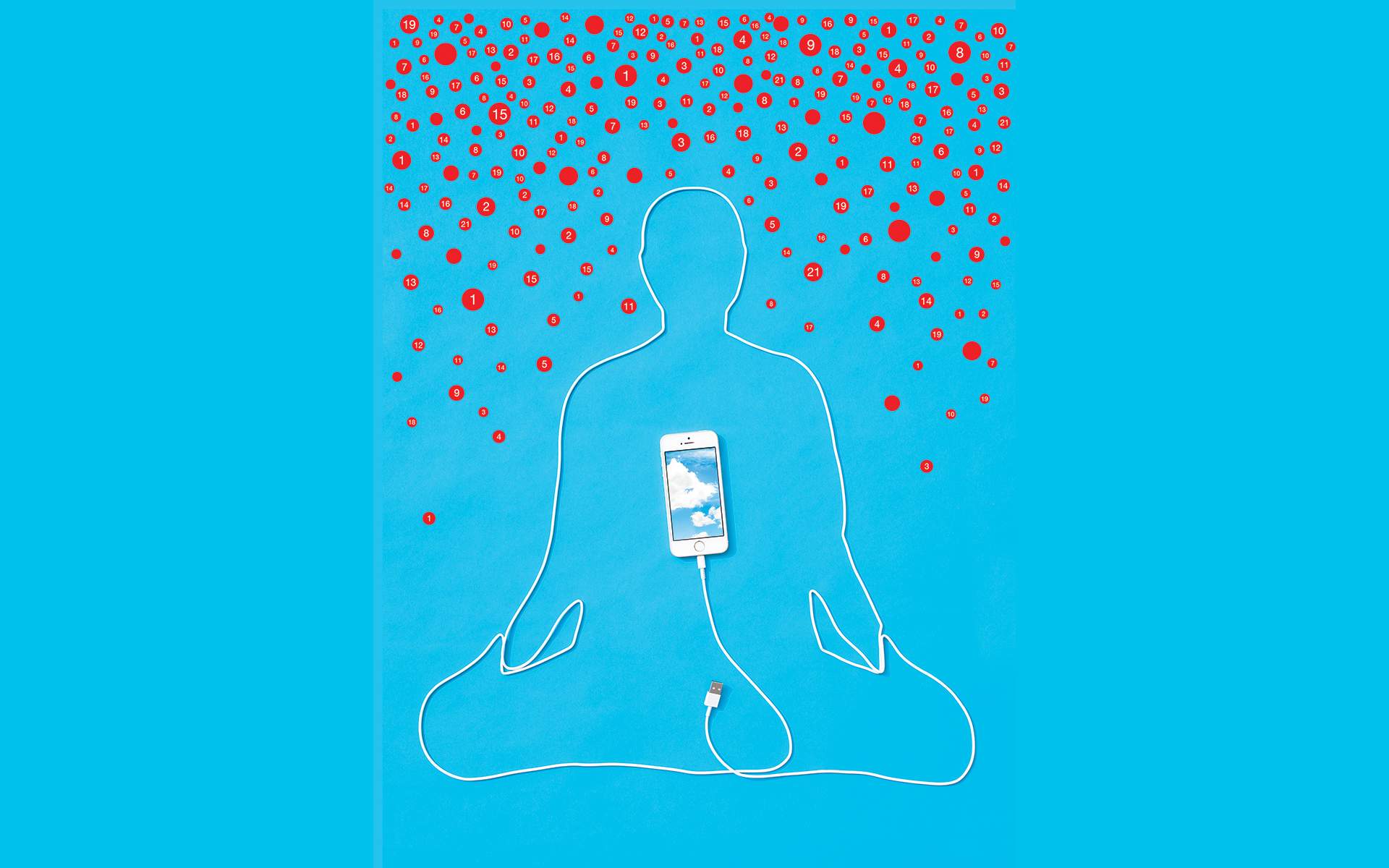With our ever-increasing use of digital technologies, the value of pausing to reconnect with what’s going on in the mind and body reveals itself in new and luminous ways. Against a constant stream of distractions, a moment of embodied presence helps us make a conscious choice about what to focus on next—and to be less reactive when our emotions get triggered. Perhaps more than anything, though, our mindfulness practice reminds us to stay curious toward all that we meet in our experience. Wherever we find ourselves—mentally or physically, online or offline—we can pause to ask: What’s going on in my mind and body right now? What is this?
As a long-time meditator and technology researcher, I’ve been exploring how this simple practice of questioning can enrich our digital lives. This curiosity can help us bring the full dimensionality of our human being into all of our digital doing across three broad areas of our everyday lives.
3 Questions to Build a Healthy Relationship with Technology
1) What are my experiences with tech actually like?
We read much in the media that questions various aspects of our relationship with technology, from the problems of misinformation to the merits and harms of social media.
It is not a practice of seeking answers. Rather, it’s a way to explore what our experience is really like.
Amidst all of this, the practice of asking “what is this?”—again and again—brings us back to our actual, lived experiences with and through technology. This practice has roots in the Zen tradition, and is used by secular practitioners. It is not a practice of seeking answers. Rather, it’s a way to explore what our experience is really like.
Practice: When checking your social media feeds, scrolling through the news, or Google searching a historical event that just popped into your head, you can make a habit of asking: What’s going on here? What background feelings am I aware of? What is the atmosphere of this online space? What is this?
Through cultivating this kind of open-ended curiosity, we can forge a better relationship with our technology. We can ask ourselves: how often (and for how long) do I want to spend each day using social media, responding to emails, or checking the news? Which devices support me best for different activities and help me to stay intentional? Where does my phone “live” at different times of the day? Through regular inquiry we can build new habits that help maintain a healthy relationship with our devices and apps.
2) What happens to my body when I’m using my phone?
Online, we don’t engage with people in the flesh. We don’t engage with ambient sounds, with light breezes, with subtle smells. We’re invited, instead, to engage only with what’s posted. As a consequence, we can get caught up in a swirl of opinions, Likes, and emojis, and our awareness of the body’s subtle textures and rhythms can easily fade away. When we enter an online space, the body all but disappears from our attention.
Practice: Next time you find yourself checking something on your phone, take a moment to ask “what is this?” from a bodily perspective. Pause to notice: are you breathing naturally or holding your breath? Are you carrying tension, or are you relaxed? What’s your awareness of your body as a whole? If you find this helpful, you might make somatic check-ins a mainstay during times when you use technology the most.
There is also a social dimension to this. The swirl of posts and comments and reactions that we find on social media platforms makes it easy to view other people in bits and pieces, through the prism of the views and opinions they put forward.
Practice: As a response, what is it like to imagine everyone we encounter on Twitter and Facebook—before all opinions or allegiances enter into the picture—as living, breathing bodies? An appreciation that we’re all human won’t resolve our differences of opinions, but it could go some way toward finding common ground in a world that is so polarized.
3) Do all of my problems need to be solved?
A criticism sometimes levelled at Silicon Valley is the rush to view everything, including the human experience, in terms of data flows. When we view everything this way, our lives become something to optimize. The expression “tech solutionism” is sometimes used to describe how our smartphones and apps are always geared towards giving us solutions, whatever the problem might be. From a tech standpoint, the notion of resting with the questions themselves—of not rushing for solutions—quite literally does not compute.
Yet, as most mindfulness practitioners will appreciate, if we see the world through the lens of fixing and controlling things, we miss out on the subtleties and fundamental mysteriousness of our moment-to-moment experience. The creaking of a branch; the distant cawing of a crow; the dance of a large cedar tree moving slowly in the breeze: we can only fully appreciate such moments if we slow down and let go of our tendency to strive for things to be different than how they are in this moment.
Practice: In response to the “optimizing” state of mind that our gadgets and apps instil within us, we can return again and again to the question, “what is this?” not in order to get the answers, but precisely as a means of freeing ourselves from constant striving. As the meditation teacher Martine Batchelor explains about the “what is this?” practice, “the anchor is the question and we come back to the question again and again.”
One Click at a Time
Our digital technologies greatly shape the context within which our lives play out. They are not, in themselves, problematic. On the contrary, we must harness their potential in order to navigate a way through the many challenges of our times, from issues of social justice and inequality through to the scale and urgency of environmental degradation.
Through continually renewing a caring, curious attitude in our online spaces and interactions we can slowly but surely work to build digital environments that bring out the best in our humanity: one click, and one breath, at a time.
Amidst it all, though, we can benefit from regularly coming back to question the nature of our actual experience. How am I showing up in online spaces? What is the quality of my interactions with others? In which online situations am I most reactive? Where am I most aware? Where am I kindest?
Through continually renewing a caring, curious attitude in our online spaces and interactions we can slowly but surely work to build digital environments that bring out the best in our humanity: one click, and one breath, at a time.
READ MORE
Can Tech Work for the Greater Good?
As tech industry leaders take steps to protect people from online platforms, founding editor Barry Boyce considers our responsibility as both consumers and meditators.
Read More
Can Your Smartphone Make You Mindful?
Meditation apps help users see mindfulness as part of their lives but they also run the risk of becoming just another tech habit.
Read More
How to Use Social Media Wisely and Mindfully
It’s time to be clear about how social media affects our relationships and well-being—and what our intentions are each time we log on.
Read More











